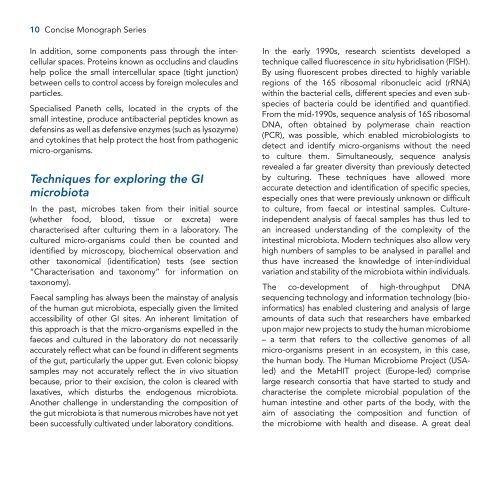probiotics, prebiotics and the gut microbiota - International Life ...
probiotics, prebiotics and the gut microbiota - International Life ...
probiotics, prebiotics and the gut microbiota - International Life ...
You also want an ePaper? Increase the reach of your titles
YUMPU automatically turns print PDFs into web optimized ePapers that Google loves.
10 Concise Monograph SeriesIn addition, some components pass through <strong>the</strong> intercellularspaces. Proteins known as occludins <strong>and</strong> claudinshelp police <strong>the</strong> small intercellular space (tight junction)between cells to control access by foreign molecules <strong>and</strong>particles.Specialised Paneth cells, located in <strong>the</strong> crypts of <strong>the</strong>small intestine, produce antibacterial peptides known asdefensins as well as defensive enzymes (such as lysozyme)<strong>and</strong> cytokines that help protect <strong>the</strong> host from pathogenicmicro-organisms.Techniques for exploring <strong>the</strong> GI<strong>microbiota</strong>In <strong>the</strong> past, microbes taken from <strong>the</strong>ir initial source(whe<strong>the</strong>r food, blood, tissue or excreta) werecharacterised after culturing <strong>the</strong>m in a laboratory. Thecultured micro-organisms could <strong>the</strong>n be counted <strong>and</strong>identified by microscopy, biochemical observation <strong>and</strong>o<strong>the</strong>r taxonomical (identification) tests (see section“Characterisation <strong>and</strong> taxonomy” for information ontaxonomy).Faecal sampling has always been <strong>the</strong> mainstay of analysisof <strong>the</strong> human <strong>gut</strong> <strong>microbiota</strong>, especially given <strong>the</strong> limitedaccessibility of o<strong>the</strong>r GI sites. An inherent limitation ofthis approach is that <strong>the</strong> micro-organisms expelled in <strong>the</strong>faeces <strong>and</strong> cultured in <strong>the</strong> laboratory do not necessarilyaccurately reflect what can be found in different segmentsof <strong>the</strong> <strong>gut</strong>, particularly <strong>the</strong> upper <strong>gut</strong>. Even colonic biopsysamples may not accurately reflect <strong>the</strong> in vivo situationbecause, prior to <strong>the</strong>ir excision, <strong>the</strong> colon is cleared withlaxatives, which disturbs <strong>the</strong> endogenous <strong>microbiota</strong>.Ano<strong>the</strong>r challenge in underst<strong>and</strong>ing <strong>the</strong> composition of<strong>the</strong> <strong>gut</strong> <strong>microbiota</strong> is that numerous microbes have not yetbeen successfully cultivated under laboratory conditions.In <strong>the</strong> early 1990s, research scientists developed atechnique called fluorescence in situ hybridisation (FISH).By using fluorescent probes directed to highly variableregions of <strong>the</strong> 16S ribosomal ribonucleic acid (rRNA)within <strong>the</strong> bacterial cells, different species <strong>and</strong> even subspeciesof bacteria could be identified <strong>and</strong> quantified.From <strong>the</strong> mid-1990s, sequence analysis of 16S ribosomalDNA, often obtained by polymerase chain reaction(PCR), was possible, which enabled microbiologists todetect <strong>and</strong> identify micro-organisms without <strong>the</strong> needto culture <strong>the</strong>m. Simultaneously, sequence analysisrevealed a far greater diversity than previously detectedby culturing. These techniques have allowed moreaccurate detection <strong>and</strong> identification of specific species,especially ones that were previously unknown or difficultto culture, from faecal or intestinal samples. Cultureindependentanalysis of faecal samples has thus led toan increased underst<strong>and</strong>ing of <strong>the</strong> complexity of <strong>the</strong>intestinal <strong>microbiota</strong>. Modern techniques also allow veryhigh numbers of samples to be analysed in parallel <strong>and</strong>thus have increased <strong>the</strong> knowledge of inter-individualvariation <strong>and</strong> stability of <strong>the</strong> <strong>microbiota</strong> within individuals.The co-development of high-throughput DNAsequencing technology <strong>and</strong> information technology (bioinformatics)has enabled clustering <strong>and</strong> analysis of largeamounts of data such that researchers have embarkedupon major new projects to study <strong>the</strong> human microbiome– a term that refers to <strong>the</strong> collective genomes of allmicro-organisms present in an ecosystem, in this case,<strong>the</strong> human body. The Human Microbiome Project (USAled)<strong>and</strong> <strong>the</strong> MetaHIT project (Europe-led) compriselarge research consortia that have started to study <strong>and</strong>characterise <strong>the</strong> complete microbial population of <strong>the</strong>human intestine <strong>and</strong> o<strong>the</strong>r parts of <strong>the</strong> body, with <strong>the</strong>aim of associating <strong>the</strong> composition <strong>and</strong> function of<strong>the</strong> microbiome with health <strong>and</strong> disease. A great deal
















